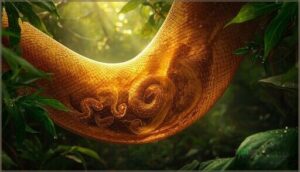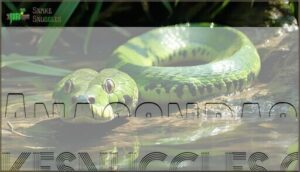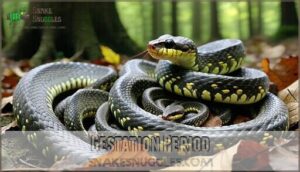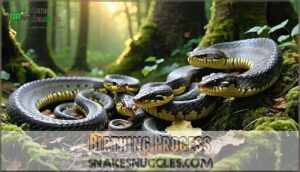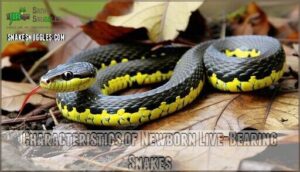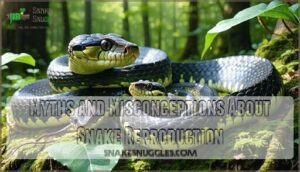This site is supported by our readers. We may earn a commission, at no cost to you, if you purchase through links.

These fascinating creatures include boa constrictors, garter snakes, copperheads, and anacondas.
They’re either viviparous, meaning they nourish babies through a placenta-like connection, or ovoviviparous, where eggs develop inside the mother’s body and hatch just before birth.
Think of it as nature’s built-in incubator system.
This reproductive strategy gives newborns a head start in harsh environments, since they’re born fully developed and ready to hunt.
The reasons behind this evolutionary adaptation reveal surprising survival advantages that might change how you view these remarkable predators.
Table Of Contents
- Key Takeaways
- Understanding Viviparity in Snakes
- Ovoviviparity Vs. Viviparity: What’s The Difference?
- Common Snake Species That Give Live Birth
- The Copperhead: a Closer Look at Live Birth
- Characteristics of Newborn Live-Bearing Snakes
- Advantages of Live Birth in Snakes
- Habitat and Environmental Factors Affecting Live Birth
- Conservation Efforts for Live-Bearing Snake Species
- Myths and Misconceptions About Snake Reproduction
- Studying Live Birth in Snakes: Research Challenges
- Frequently Asked Questions (FAQs)
- What kind of snake has live babies?
- Do copperheads have live births?
- Do garter snakes have live babies?
- Do any reptiles have live births?
- What snakes have live babies?
- Do copperheads give live birth?
- Do garter snakes have live births or lay eggs?
- What does a baby copperhead snake look like?
- How do newborn snakes hunt after birth?
- What role do male snakes play in reproduction?
- Conclusion
Key Takeaways
- You’ll find that about 20% of snake species give live birth instead of laying eggs, including familiar species like copperheads, garter snakes, boa constrictors, and anacondas.
- You’re looking at two types of live birth: viviparous snakes that nourish babies through placenta-like connections, and ovoviviparous snakes where eggs develop internally and hatch just before birth.
- You’ll discover that newborn live-bearing snakes are born fully equipped with venom and fangs, and hunting instincts—they don’t need any parental care and can survive independently from day one.
- You’ll see that live birth gives these snakes major survival advantages by protecting developing young from predators and harsh temperatures, allowing them to thrive in challenging environments where eggs wouldn’t survive.
Understanding Viviparity in Snakes
You’ve probably never thought about snakes giving birth to live babies, but it’s more common than you’d expect.
Snake live birth isn’t just unusual—it’s evolutionary genius that guarantees species survival in challenging environments.
This fascinating process, called viviparity, occurs when snake mothers nourish their developing young internally rather than laying eggs.
Unlike most reptiles, viviparous snakes provide placental nourishment to their offspring, making enormous maternal investment in each baby.
Viviparity evolution happened for good reasons.
Cold climates often kill eggs, so livebearing snakes evolved to protect their young inside their bodies.
This snake reproductive strategy requires significant reproductive energy and extends gestation length, but it dramatically improves survival rates.
Viviparous species like rattlesnakes, boas, and water snakes represent about 20% of all snake species.
Their snake reproduction method mirrors mammals more than typical reptiles.
This adaptation showcases nature’s incredible flexibility, proving that snake live birth isn’t just unusual—it’s evolutionary genius that guarantees species survival in challenging environments.
Ovoviviparity Vs. Viviparity: What’s The Difference?
When considering livebearing snakes, you’ll encounter two distinct reproductive strategies that often get mixed up.
Both ovoviviparous snakes and viviparous species give live birth, but their methods differ substantially.
| Aspect | Ovoviviparous | Viviparous |
|---|---|---|
| Egg Retention | Eggs develop inside mother’s body | No eggs formed |
| Nourishment Source | Yolk sac only | Placental Nourishment |
| Energy Investment | Moderate maternal input | High maternal energy cost |
| Development | Hatches internally before birth | Direct embryonic development |
| Examples | Rattlesnakes, copperheads | Garter snakes, some boas |
Think of ovoviviparous snakes as having "internal incubators" – they’re basically egg-layers who’ve evolved to keep their eggs inside until hatching.
True viviparous species skip the egg stage entirely, nourishing developing young directly through their bloodstream.
These reproductive adaptations, such as internal embryonic development, help different snake species thrive in various environments, from aquatic habitats to cold climates where external eggs wouldn’t survive.
Common Snake Species That Give Live Birth
You’ll find several familiar snake species among those that give live birth, including copperheads, garter snakes, boa constrictors, and anacondas.
These common examples demonstrate how live birth occurs across different snake families, from venomous pit vipers in your backyard to massive constrictors in tropical regions.
Copperheads
Now you’ll meet the copperhead, a viviparous snake that gives live birth instead of laying eggs.
These snake offspring emerge ready to hunt, equipped with potent copperhead venom from day one.
Found in copperhead habitats like rocky woodlands, they face threats from habitat loss.
Their copperhead diet includes rodents and insects, supporting a copperhead lifespan of 18 years.
Copperhead conservation efforts focus on habitat protection and education.
This adaptation helps reduce neonatal deaths from predation.
Garter Snakes
You’ll recognize garter snakes as nature’s most prolific live-birth champions. These viviparous reptiles showcase fascinating snake reproduction patterns, with mating swarms creating dramatic courtship scenes where dozens of males compete for one female.
Their sperm storage ability lets females delay fertilization for years, timing births perfectly with seasonal conditions. This remarkable adaptation guarantees snake offspring survive harsh winters.
Regional variations affect their reproductive success across diverse garter snake habitats:
- Plains garter snakes typically birth 10-40 live offspring in late summer
- Eastern species adapt birthing timing to local climate patterns
- Mountain populations synchronize births with ideal temperatures
Boa Constrictors
Boa constrictors represent one of the most recognizable types of livebearing snakes in the world.
These powerful serpents give birth to fully-formed young after a boa gestation period of four to five months.
Unlike many snake reproduction methods, boas don’t require neonate care since babies arrive ready to hunt.
Found across diverse boa habitats from rainforests to grasslands, these common livebearing snakes showcase remarkable constricting adaptations.
Their breeding frequency occurs every two to three years, making each live birth event particularly significant for population survival.
Anacondas
Living in South America’s wetlands, anacondas represent nature’s most impressive live-bearing snakes.
These viviparous giants dwarf boa constrictors in both anaconda size and reproductive scale, with females birthing up to 40 young after lengthy gestation periods.
- Aquatic adaptations allow females to maintain ideal body temperature during pregnancy
- Predatory behavior focuses on constriction rather than venom for hunting success
- Conservation status remains threatened due to habitat destruction and human encroachment
- Birthing frequency occurs every two to three years depending on environmental conditions
- Snake birthing process produces fully independent offspring requiring no parental care
The Copperhead: a Closer Look at Live Birth
You’ll find copperheads among North America’s most fascinating ovoviviparous snakes, carrying their young internally until they’re ready for live birth.
When you examine their reproductive cycle, you’ll discover these venomous pit vipers follow a precise pattern of mating, gestation, and birthing that sets them apart from egg-laying species, making them a unique example of ovoviviparous snakes.
Mating Habits
Copperhead courtship rituals showcase nature’s intricate dance of reproduction.
These venomous snakes don’t mess around in terms of finding mates, employing sophisticated strategies that’d make dating apps jealous.
- Male Competition – Males engage in ritualized combat dances, intertwining bodies to establish dominance
- Courtship Rituals – Winners perform elaborate chin-rubbing displays to woo females
- Mating Swarms – Multiple suitors gather around receptive females during peak breeding season
- Sperm Storage – Females can store sperm for months, timing reproduction perfectly
Gestation Period
Snake gestation for copperheads spans 3-4 months, creating nature’s perfect nursery.
During this gestation length, the female’s body becomes a living incubator where maternal health directly impacts developing young.
She’ll carefully regulate temperature through strategic basking, while environmental impact influences her choices.
This viviparous process showcases remarkable evolutionary pressures that shaped live birth strategies, with litter size typically ranging from 4-8 babies per snake pregnancy.
Baby copperheads are born with distinctive yellow tail tips.
Birthing Process
After the gestation length concludes, labor signs signal the start of copperhead’s remarkable birthing process.
These ovoviviparous snakes deliver live young without needing neonate care from mom.
Snake birthing processes showcase nature’s efficiency through three key features:
- Newborns arrive fully equipped with venom and fangs for immediate hunting
- Yellow tail tips function as built-in fishing lures to attract prey
- Strategic birthing locations near winter dens guarantee offspring survival during harsh conditions
This snake livebearing adaptation maximizes survival rates.
Characteristics of Newborn Live-Bearing Snakes
When you observe newborn live-bearing snakes, you’ll notice they’re remarkably independent from their first breath, arriving fully equipped with functioning venom glands, sharp fangs, and hunting instincts that let them tackle prey immediately.
You’ll find these miniature predators are basically scaled-down versions of their parents, complete with defensive behaviors and the ability to survive without any parental care.
Unlike many other reptiles that require extended nurturing, these snakes are able to thrive on their own, making them uniquely independent from a very young age.
Size and Appearance
Right after birth, you’ll notice these neonates aren’t miniature versions of their parents.
Snake size varies dramatically among live-bearing species, with snakelets ranging from tiny garter snake babies to surprisingly large anaconda offspring.
Color variation often matches adult patterns, though some species display unique markings that fade with age.
Scale patterns remain consistent from birth, helping with identification.
Body proportions differ slightly, as newborns typically have larger heads relative to their body size.
It’s important to make certain proper care products are available for garter snake babies.
| Species | Birth Length | Notable Features |
|---|---|---|
| Copperhead | 7-9 inches | Bright yellow tail tip |
| Garter Snake | 5-9 inches | Vivid stripe patterns |
| Boa Constrictor | 14-22 inches | Muscular build from day one |
Venom Production
Don’t underestimate these pint-sized predators—they’re born locked and loaded! Newborn viviparous and ovoviviparous venomous snakes emerge with fully functional venom delivery systems that rival their parents’ capabilities.
Baby snakes pack deadly punches from day one—no training wheels needed for these tiny assassins!
Here’s what makes these tiny terrors so formidable:
- Venom Composition: Often more potent than adult venom
- Venom Function: Immediate defensive and hunting capabilities
- Venom Evolution: Refined through live birth advantages
- Venom Potency: Concentrated toxins for maximum impact
These newborn snakes require specialized venom extraction tools for research.
These serpentine newborns don’t mess around—they’re ready to strike from their first breath.
Survival Instincts
Beyond their deadly venom, newborn snakes possess remarkable survival instincts that kick in immediately after birth.
You’ll find these neonates don’t rely on maternal care – they’re born ready to hunt, hide, and defend themselves.
Their environmental adaptation skills are impressive, from predator avoidance techniques to resource competition strategies.
Young copperheads use their bright yellow tail tips as fishing lures, wiggling them to attract prey.
Understanding innate snake behaviors is key to appreciating their survival instincts.
This neonate defense mechanism shows how snake survival depends on instinct rather than learning.
| Survival Strategy | Purpose | Success Rate |
|---|---|---|
| Tail luring | Prey attraction | 60-70% |
| Defensive striking | Predator avoidance | 80-90% |
| Camouflage hiding | Protection from threats | 85-95% |
The use of tail luring and defensive striking highlights the effectiveness of these strategies in ensuring the snakes’ survival.
These survival strategies are crucial for the snakes to thrive in their environment.
Advantages of Live Birth in Snakes
When you examine live birth in snakes, you’ll discover several evolutionary advantages that make this reproductive strategy a winner. Predation Reduction stands out as the biggest benefit—newborns skip the vulnerable egg stage where they’re sitting ducks for hungry predators.
Thermal Regulation becomes easier too, since developing young stay warm inside mom’s body rather than depending on environmental temperatures.
Viviparous and ovoviviparous species enjoy Habitat Expansion opportunities, allowing them to colonize cooler climates where eggs wouldn’t survive. This snake live birth evolution represents smart Energy Investment—while mothers spend more calories during gestation, Offspring Survival rates skyrocket.
These snake reproductive adaptations guarantee babies emerge fully formed, mobile, and ready to hunt immediately. Viviparity evolved in colder climates, offering vital embryo protection. It’s nature’s way of giving snake babies the best possible head start in life.
Habitat and Environmental Factors Affecting Live Birth
When you observe live-bearing snakes in the wild, you’ll notice their reproductive success depends heavily on finding suitable birthing sites near winter dens, adequate shelter, and stable temperatures.
Climate change now threatens these critical habitat requirements, forcing species like garter snakes and rattlesnakes to adapt their traditional birthing locations and timing to guarantee their offspring’s survival, which is crucial for the species’ reproductive success.
Birthing Rookery Locations
Live-bearing snakes choose birthing locations like seasoned real estate agents. Female copperheads and other species select specific rookery microclimates that offer ideal conditions for their young.
These sites demonstrate remarkable site fidelity, with generations returning to proven locations despite predator abundance concerns.
Key factors in snake reproductive strategies include:
- Rocky outcrops providing thermal regulation and protection
- Dense vegetation offering camouflage from aerial predators
- Proximity to water sources ensuring adequate humidity levels
- Established escape routes allowing quick natal dispersal when threatened
Conservation strategies now focus on protecting these critical snake habitats.
Winter Den Proximity
When viviparous snakes give birth, they’re strategic about winter den proximity.
Smart mothers choose birthing sites within reasonable natal den distance, reducing hibernation proximity risks for newborns.
Den site selection often creates overlap with rookeries, where multiple females birth near shared winter shelters.
This winter den sharing approach maximizes survival chances, as juveniles don’t waste precious energy traveling far distances before their first hibernation period.
These dens provide essential shelter from predators.
Climate Change Effects
Climate change is turning the heat up on live-bearing snakes, forcing dramatic shifts in their survival strategies.
Rising temperatures and habitat loss create a perfect storm affecting reproduction rates and prey availability across geographic ranges.
Here’s how climate change impacts snake live birth mechanisms:
- Temperature Impacts disrupt ideal gestation conditions for developing embryos
- Geographic Shifts force species into unfamiliar territories with different survival challenges
- Habitat Loss eliminates traditional birthing sites and winter dens
- Prey Availability changes as food webs shift with environmental conditions
- Reproduction Rates decline when snake evolutionary adaptations can’t keep pace with rapid changes
These environmental pressures directly threaten snake species survival, as mothers struggle to find suitable conditions for successful live births in their changing snake environment.
Conservation Efforts for Live-Bearing Snake Species
Protecting live-bearing snake species requires thorough snake conservation efforts that address multiple challenges.
Habitat preservation safeguards critical breeding areas where these species give birth, while climate resilience strategies help populations adapt to changing environments.
Controlling invasive species prevents competition for resources, and maintaining genetic diversity strengthens populations against disease.
Public awareness campaigns reduce human-snake conflicts by educating communities about snake reproductive biology and ecological benefits.
Organizations like Save the Snakes coordinate international conservation programs, supporting field research and community outreach initiatives across threatened habitats.
Creating a welcoming environment that emphasizes natural pest control can further support snake populations.
Myths and Misconceptions About Snake Reproduction
Regarding snake reproduction, misconceptions run wild like urban legends.
Many people assume all snakes are oviparous, but that’s simply not true.
Here are four common snake myths that need debunking:
- **All snakes lay eggs?
** – About 30% are viviparous or ovoviviparous, giving live birth
- **Viviparity equals mammals?
** – Snake livebearing evolved independently
- Snake pregnancy length is always short – Some species carry young for months
- Parental care myths suggest snakes abandon offspring immediately
Studying Live Birth in Snakes: Research Challenges
Snake reproductive research faces unique obstacles that’d make any scientist pull their hair out.
Field observation becomes nearly impossible when you’re tracking secretive species like rattlesnakes across vast prairie landscapes.
You’ll spend countless hours waiting for pregnant females to reveal their birthing locations, often coming up empty-handed.
Data collection gets complicated when sample sizes remain frustratingly small—viviparous and ovoviviparous species don’t exactly cooperate with research schedules.
Genetic analysis requires expensive equipment and specialized training that many field stations can’t afford.
Ethical considerations add another layer of complexity, as disturbing pregnant snakes could harm both mothers and developing offspring.
Snake evolution studies demand decades of continuous monitoring to understand reproductive patterns.
Laboratory conditions rarely mirror wild environments, making captive breeding studies less reliable.
Despite these hurdles, researchers keep pushing forward, slowly unraveling the mysteries of live birth in these fascinating reptiles.
Frequently Asked Questions (FAQs)
What kind of snake has live babies?
You’ll find nature’s little miracle workers include garter snakes, rattlesnakes, boas, and anacondas. These serpents skip the egg-laying routine, carrying their young internally before birthing live, ready-to-hunt babies.
Do copperheads have live births?
Yes, you’ll find that copperheads give birth to live young rather than laying eggs.
They’re ovoviviparous, meaning eggs develop inside the mother and hatch internally before she delivers live babies in thin amniotic sacs.
Do garter snakes have live babies?
Picture tiny serpents wriggling free from their mother’s body—that’s exactly what you’ll witness with garter snakes.
They’re ovoviviparous, meaning eggs hatch internally before live birth, producing 10-40 babies at once.
Do any reptiles have live births?
Many reptiles give live birth instead of laying eggs.
You’ll find viviparous species among snakes, lizards, and even some skinks.
About 20% of all reptile species have evolved this fascinating reproductive strategy.
What snakes have live babies?
Boas birth live young, rattlesnakes deliver living babies, and garter snakes give live birth too.
You’ll find anacondas, sea snakes, vipers, and water snakes all skip egg-laying, instead carrying their offspring internally until they’re ready, which is a remarkable process.
Do copperheads give live birth?
Copperheads are ovoviviparous, meaning they give birth to live young.
You’ll find that baby copperheads develop inside eggs within the mother, then hatch internally before being born in thin amniotic sacs.
Do garter snakes have live births or lay eggs?
Garter snakes give live birth rather than laying eggs. They’re ovoviviparous, meaning eggs develop inside the mother and hatch internally before she delivers 10-40 live babies, typically during late summer.
What does a baby copperhead snake look like?
Like tiny copper pennies with attitude, baby copperheads sport distinctive hourglass-shaped crossbands across their backs.
You’ll notice their bright yellow-green tail tips, which they wiggle like worms to lure prey before striking.
How do newborn snakes hunt after birth?
Newborn snakes are born with fully developed instincts and hunting abilities.
They’ll immediately use their keen sense of smell, heat detection, and quick reflexes to track down small prey like insects, worms, and tiny rodents independently, utilizing their keen sense of smell and quick reflexes.
What role do male snakes play in reproduction?
Male snakes typically compete aggressively for females during mating season, sometimes forming large swarms around a single female. They don’t provide parental care afterward, leaving reproduction responsibilities entirely to females.
Conclusion
Like nature’s own nursery system, these remarkable reptiles have evolved beyond the typical egg-laying stereotype.
You’ve discovered that snakes with live babies represent some of the most adaptable species on Earth, from venomous copperheads to massive anacondas.
Their viviparity and ovoviviparity strategies provide essential survival advantages in challenging environments.
Understanding these reproductive methods helps dispel common myths while highlighting the incredible diversity within snake species.
These fascinating creatures continue to surprise researchers with their evolutionary innovations.

